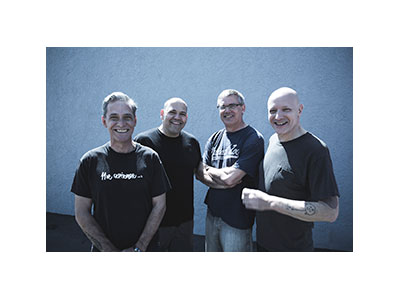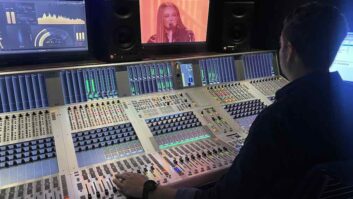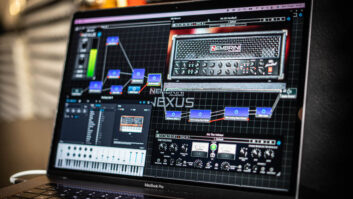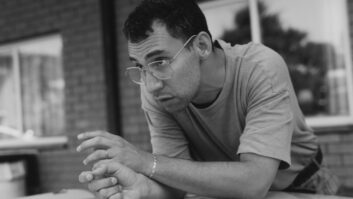
If age mellows, then the Descendents are punk music’s Dorian Gray. It’s been 12 years since they last released an album, and their latest LP, Hypercaffium Spazzinate, explodes into headphones as though the quartet could no longer keep it in. They continue their progression of writing scathing anthems of their (current) age, so now, with the band members in their early 50s, they cover real-life issues such as infidelity, divorce, loneliness, high cholesterol, and failing health in both poignant and humorous ways.
From their playful early days to first “real” jobs and adult relationship issues, the Descendents have grown with their audience, both lyrically and sonically, proving that you can move forward and not lose your punk pedigree. Crafting the sound on this hyperactive new release are musicians and co-producers Stephen Egerton (guitar) and Bill Stevenson (drums), and mix and mastering engineer Jason Livermore.
The bulk of the tracking and mixing work took place at The Blasting Room, Fort Collins, Colo., a studio owned by Stevenson and Livermore, but that doesn’t mean that the band played there. Over the years, the band members dispersed around the country—singer Milo Aukerman now lives in Delaware, bassist Karl Alvarez and Stevenson are in Colorado, and Egerton is settled in Oklahoma. Each member of the Descendents is an accomplished songwriter, and each had their own tunes to share across the miles.
Blast Off
That is how the process started more than three years ago—with each member sending locally recorded demo tracks to Stevenson and Livermore at The Blasting Room. “We tracked the songs in three different sessions,” says Livermore, who also worked on the Descendents’ previous two releases, Everything Sucks (1996) and Cool to Be You (2004). “We did Milo’s songs first in one session, then Karl’s and Stephen’s in another, and then Bill’s in the third.”
Stevenson would take the demos and record his drum parts over them, with these drum tracks intended for use on the final recordings. Producing as he drummed, he sometimes upped the ante as he played: “On some of the songs Milo gave us the tempo felt too slow, so Bill upped the tempo when laying in his tracks. Bill usually speeds up the drums a lot after he has too much coffee; the tracks start to get really fast.”
Livermore confesses to being a fan of the Descendents, with the band’s classic debut LP Milo Goes to College (1982) being one of the first records he ever bought. “I love the drum sound from that album, so I tried to get the sound to be similar to that,” Livermore says. “It is a tight, dry drum sound on Milo. Crazy dead. And we went for that. Our Studio A is medium-live, and I encased the drums in baffles and then we deaden them up further with Moongel damper pads. That was the technique we used to get them to sound how we wanted before we even put mics on them.”
Once miked, the drums were fed into an Endless Analog CLASP that let them record to tape and to Pro Tools simultaneously, “so you get the tape saturation,” adds Livermore. “It is like working in Pro Tools, but using the tape machine as an effect. I track the drums to our Otari MTR90 III. Most of the close mics went to UTA MPEQ-1 channel strips, which have a magical EQ. You can go really surgical or really wide. I EQ’d the drums pretty heavily during tracking.” The hat/ride and room mics went to Classic Audio VP28 mic pre’s.
Bringing It Together
Despite the physical distance, the Descendents remain a tight-knit band (the bonds that tie them together are nicely described in the Stevenson-penned “Beyond the Music” on Hypercaffium Spazzinate). So, with the drum parts done, it was time for some togetherness. Next up: Karl Alvarez’s energetic bass lines.
Alvarez went to Stevenson’s house to track his parts. “Bill and Karl tracked the bass to DI through a Chandler Channel with no compression,” says Livermore. “But Karl has a really dark tone, naturally. So Bill put close to 10 plug-ins on it before he gave it to me, so it is essentially 30 to 50 dB brighter. He used three separate de-essers to attack the spots that got unruly, and he put in a SansAmp plug-in, as well. It was close by the time it got to me, so that, when I mixed it, I used no compression—just a little EQ per song.” The bass was re-amped through an Ampeg SVT-4 PRO.
Rhythm and lead guitars were primarily handled by co-producer Egerton in his own studio, where he tracked all his parts DI using the Eleven Free plug-in that comes with Pro Tools. “He’s really fond of that,” offers Livermore.
When the guitar tracks arrived back at the Blasting Room, Livermore and Stevenson re-amped his guitar through a 50-watt EVH 5150, which, according to Livermore, sounds “less metal-y and more Marshall-y,” and a 1969 Traynor Bassmaster YBA-1, which provided the cleaner Milo Goes to College tone.
Jason Livermore mans the Blasting Rooms Mastering Suite.
Group Effort
For Auckerman’s distinctive vocals, the singer rented a small house near where he lives and set up a recording space in the basement. There he sang through a Shure SM7 into a Neve Portico 5015 single-channel pre/compressor. He tracked it there himself and sent the files to Egerton.
However, as Livermore states, “Bill is pretty picky, and he flew out to Milo’s place and helped him with the tunes that Bill wrote, and re-did a few of the others. Milo has few vocal personas, so if he sings too soft, it doesn’t sound like it is supposed to. Bill encouraged Milo to sing harder to get more edge.”
With all the tracks recorded, Livermore started mixing, passing versions along to the producers for feedback until everyone was pleased. Mixing was done on Studio A’s Solid State Logic SL6000E (which once belonged to Babyface, but has been a fixture in The Blasting Room since 1997). Then he tackled the mastering of the project by using an IGS Tubecore, API 550M EQs, and a Hendyamps Michaelangelo EQ. All this was connected by Dangerous Audio’s Liaison, before being captured to Soundblade via Prism ADA-8XR converters.
But Wait, There’s More
The Descendents’ decision to work at their own pace—and in their own style—provided a wealth of material for the band to choose from. They tracked and mixed 36 songs in total, so, in addition to the 16 tracks on the standard edition of Hypercaffium Spazzinate (named after biochemist Auckerman’s desire for a super-potent form of the band’s beloved caffeine), and the five more on the extended edition, there are another 15 songs that are finished and that have not been released.
“I feel like this album is great,” says Livermore. “And I think it helps having a big chunk of songs to choose from.”
Livermore is not wrong—Hypercaffium Spazzinate delivers on the Descendents’ reputation for fast-paced, thoughtful and oftentimes fun punk, and, in listening, it’s hard to believe that it wasn’t recorded with the four friends sharing coffees and staring at one other across Studio A.
With 15 finished songs at the ready, here is hoping we won’t have to wait another 12 years for a fresh dose of the Descendents.







